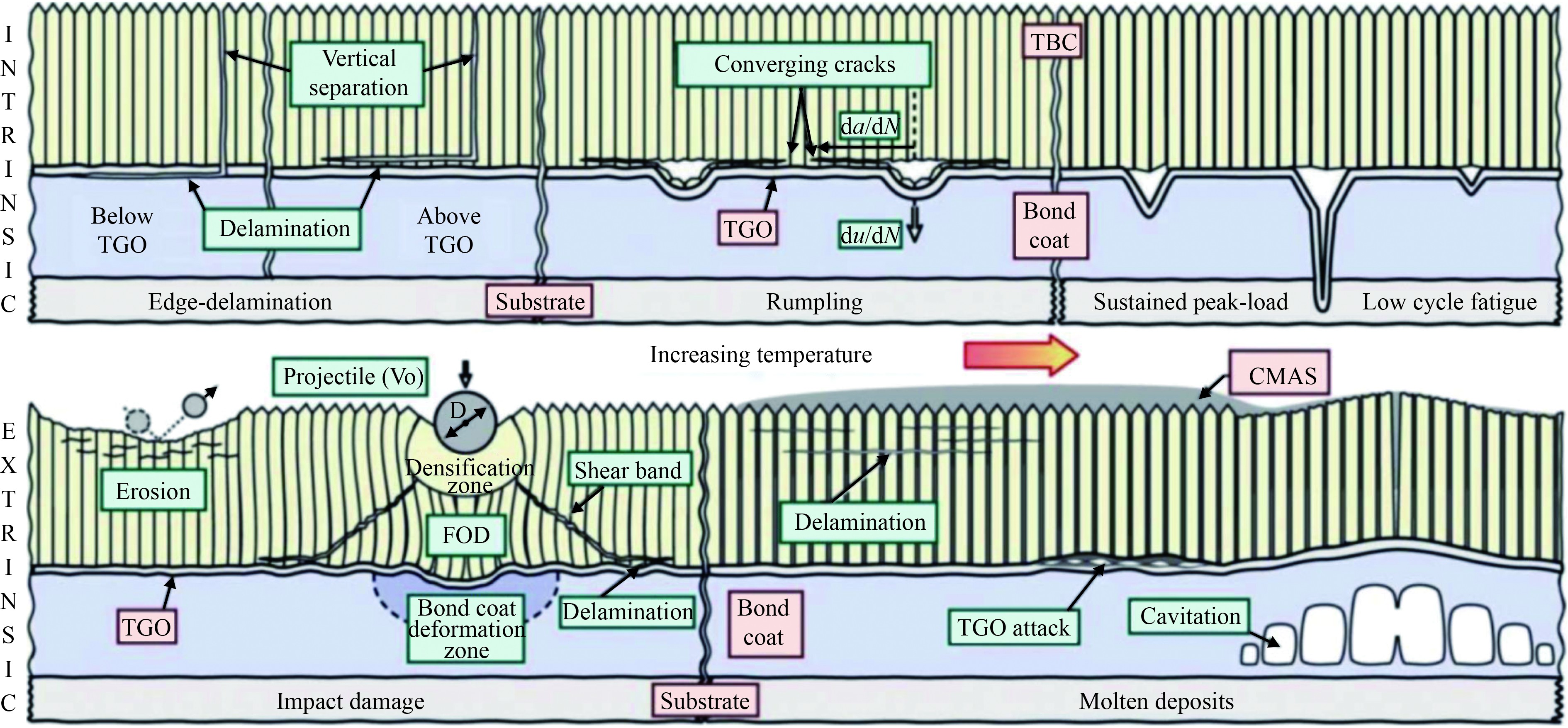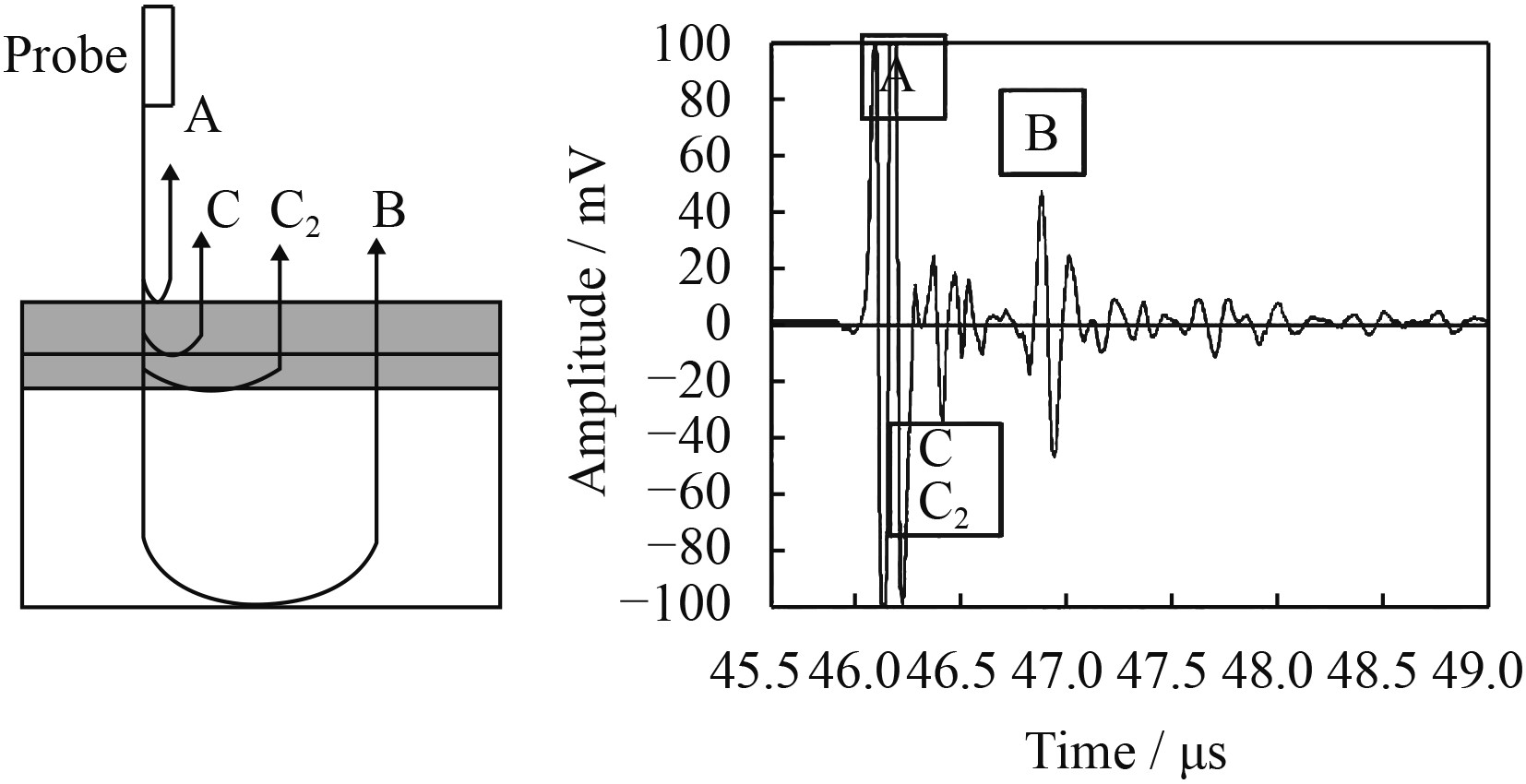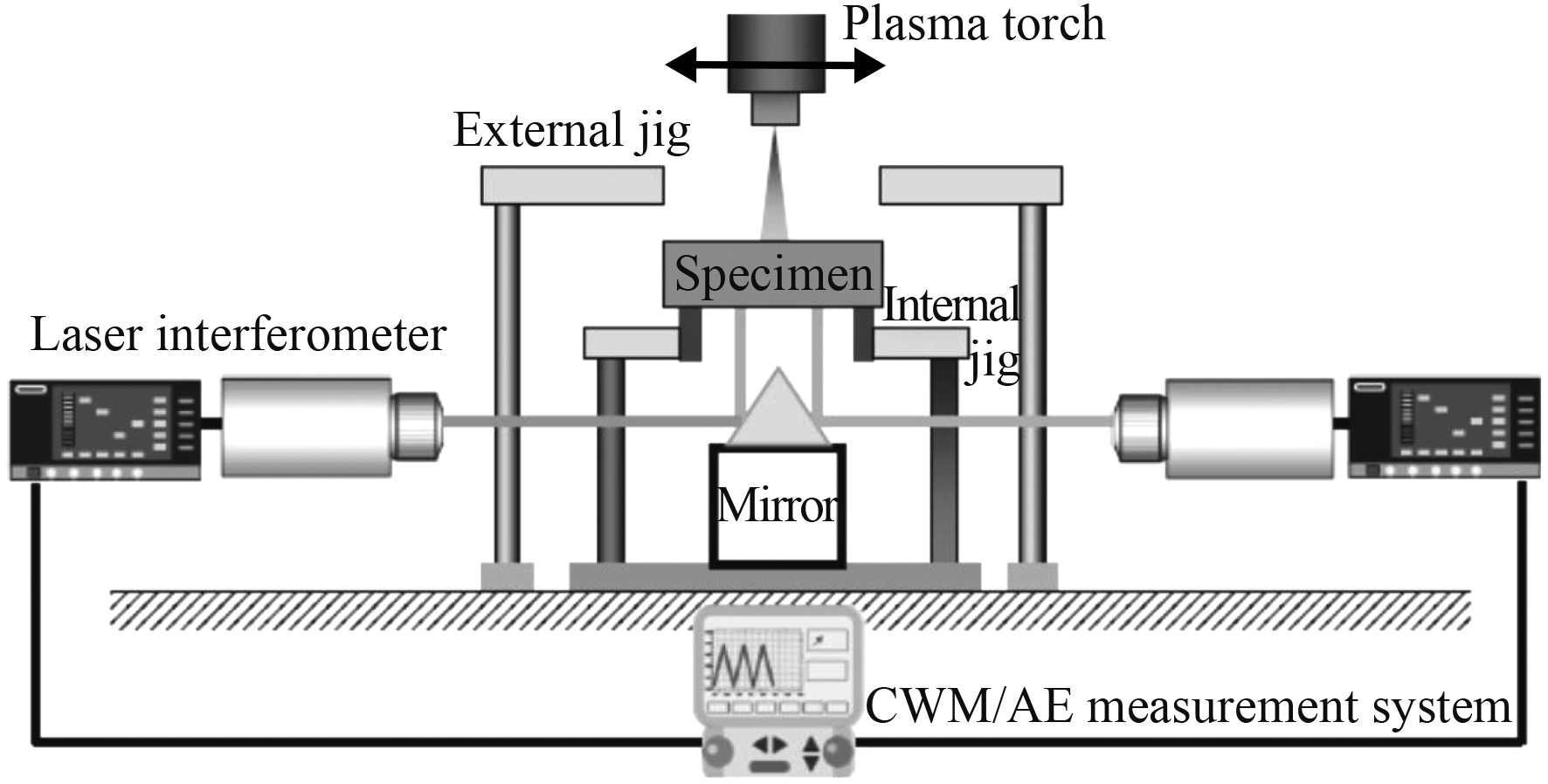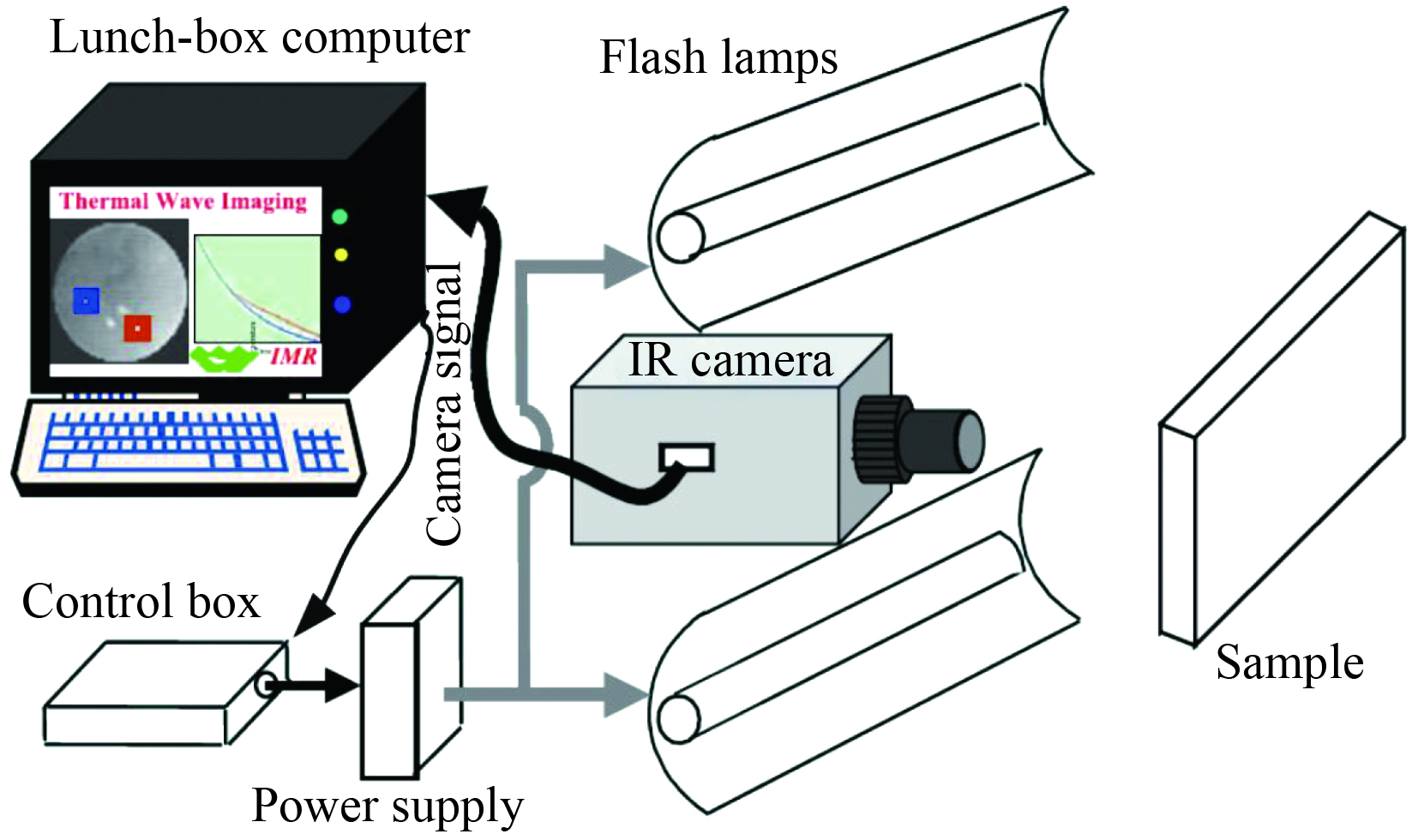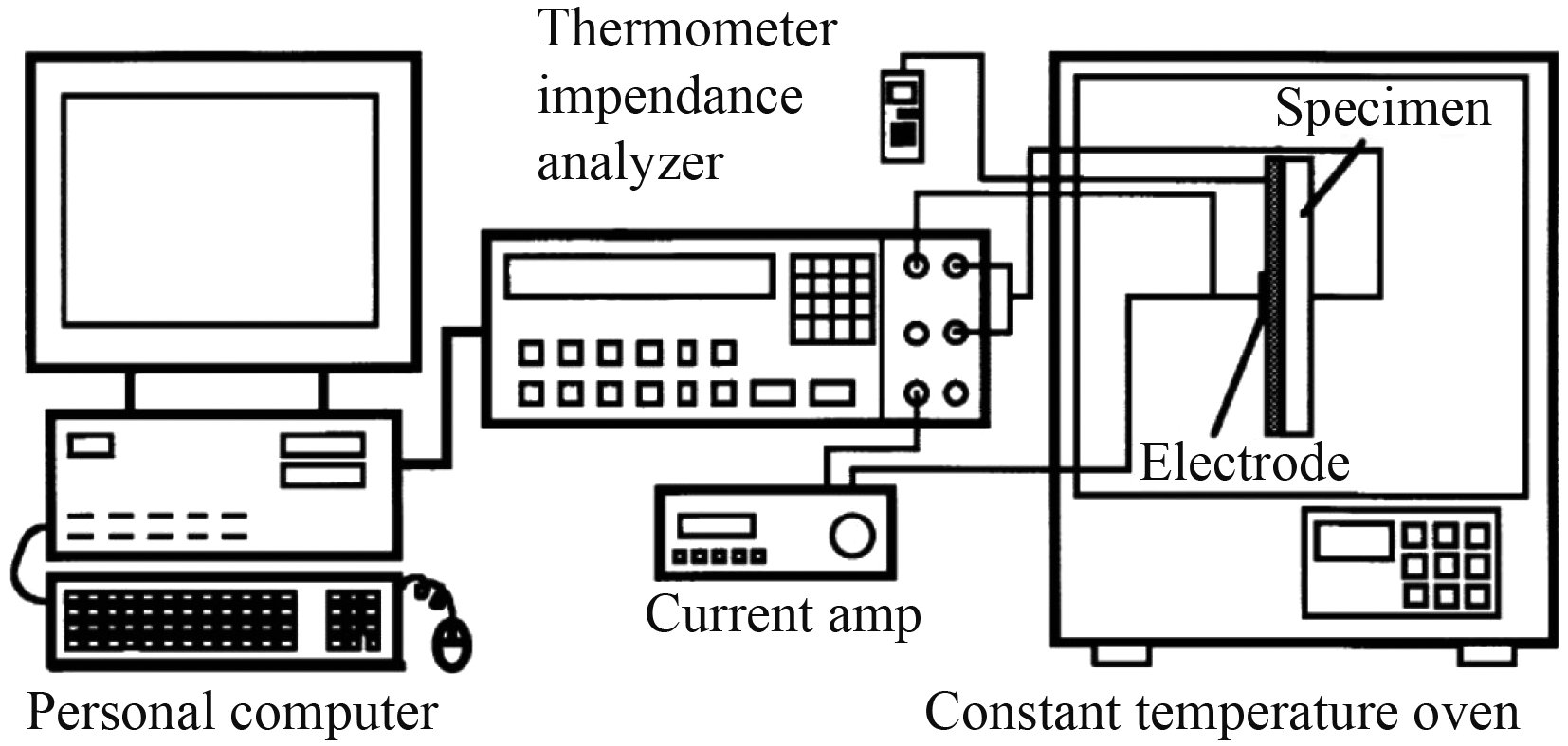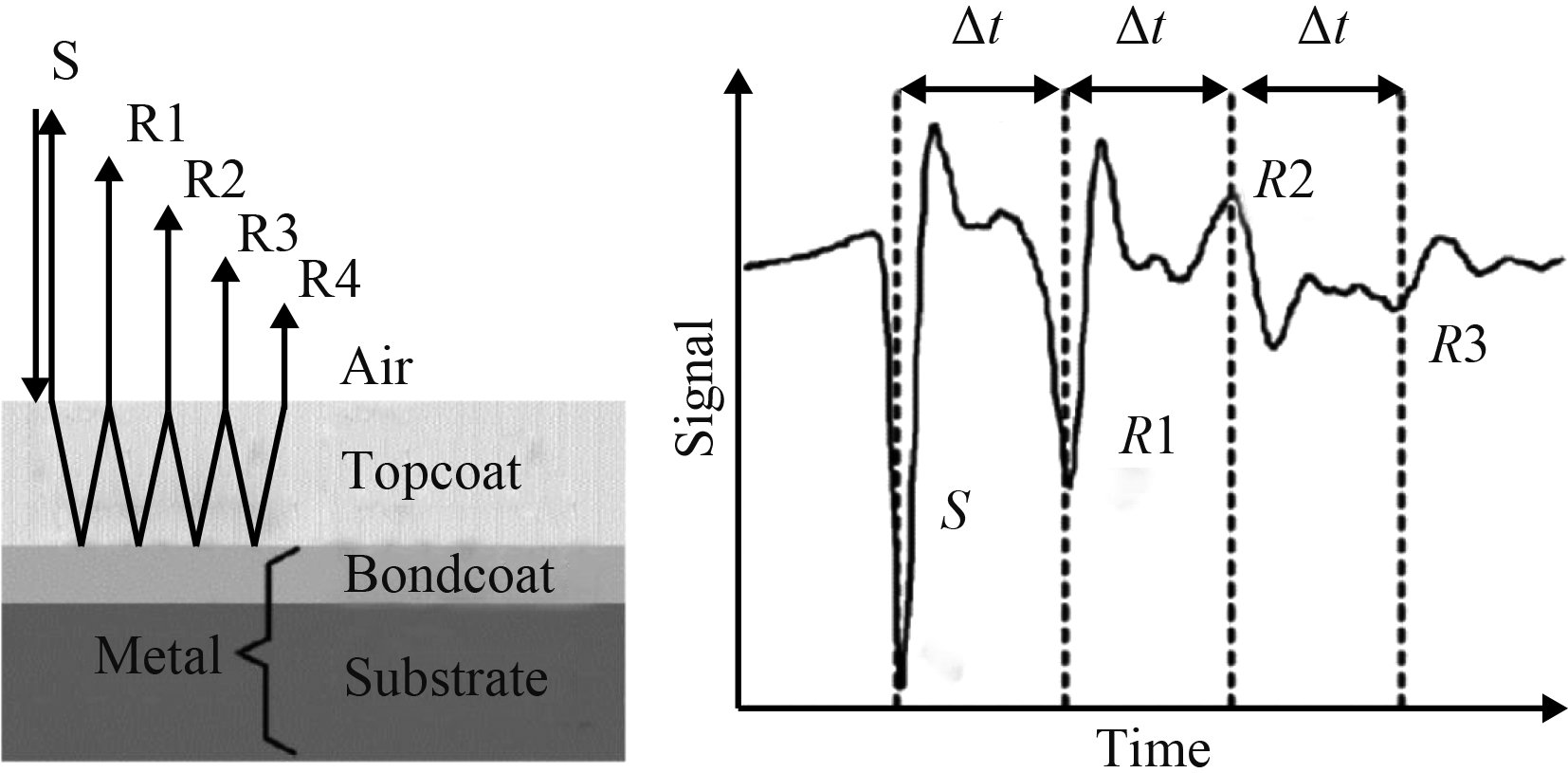热障涂层(Thermal barrier coatings, TBCs)主要由金属粘结层和陶瓷隔热层组成,其中金属粘结层的材料主要为MCrAlY(M:Ni or/and Co)或NiPtAl,主要起到高温抗氧化的作用;陶瓷层一般为氧化钇部分稳定氧化锆材料(ZrO2-8%Y2O3, 8YSZ),主要起到延缓热传导作用。热障涂层在服役环境中不仅承受着高温、高压的燃气,而且还承受着高热流输入、高温度梯度、应力梯度、离心力等作用[1-3]。因此,热障涂层失效机理复杂,EVANS和LEVI等[4-5]总结了电子束物理气相沉积(Electron beam physical vapor deposition, EB-PVD)热障涂层的失效机制,如图1所示。内部因素主要指热障涂层体系中各层热膨胀系数的不匹配、热生长氧化物(Thermally grown oxide,TGO)产生后引起的界面裂纹、陶瓷层的烧结等;外部环境因素主要包括高温冲蚀失效和CaO-MgO-Al2O3-SiO2 (CMAS)腐蚀失效等。
由于热障涂层具有特殊的微结构和多界面、多相特点,同时在恶劣的服役环境下涂层存在组织结构退化、微裂纹萌生扩展、热物性和力学性能退化、涂层减薄、TGO生长、应力水平变化等现象,传统的涂层质量评价和性能表征多依靠破坏式检测和模拟服役环境测试,亟待在制备态涂层质量控制及涂层服役阶段状态诊断方面发展简单可行和快捷的无损检测方法。目前,欧美发达国家在无损检测领域开展了大量的研究和一定的应用,美国能源部为了满足燃气轮机和航空发动机涡轮热端部件材料的研制发展需求,设置了DOE-NTEL计划,其中重点针对热障涂层监测、测试及性能表征的无损检测技术开展了研究,发展了声发射技术、红外热成像技术、光激发荧光压电光谱等无损检测技术,并系统的开展了无损检测信号和涂层性能、特征变化的规律性研究[6-10]。目前,红外热成像技术针对陶瓷涂层分层剥离,声发射技术针对模拟服役环境中涂层裂纹监测等研究取得了一定进展。涡流检测技术可用于涂层内部大面积气孔、TGO层中β-Al2O3层的厚度以及陶瓷层的剩余厚度检测,进而定性分析涂层的状态和剩余寿命[11-12]。国内外目前均已研制出涂层厚度涡流检测仪,并且国外已经成功将其应用于燃气轮机叶片涂层质量检测[13],但该方法大多数研究应用还集中在单层涂层的厚度测量,很少考虑多层涂层的导电性对厚度测量的影响,测量精度低,尚无法应用于多层导电涂层检测[14]。
热障涂层具有多层、多界面和多相结构,其性能变化与制备材料、工艺及工艺参数密切相关,且其在服役过程中不断发生退化(陶瓷层的烧结及相变、裂纹缺陷的产生等),这些因素使得维持热障涂层无损检测技术测量涂层性能的准确度变得极其困难,如对于涡流检测,陶瓷层厚度检测受粘结层影响[15];对于红外热成像检测,检测精度受涂层厚度和导热系数影响。针对热障涂层生产过程中的质量控制和服役过程中的维修问题,目前热障涂层无损检测研究主要集中在厚度测量、缺陷检测和涂层剩余寿命评估方面。根据不同热障涂层无损检测方法的特点,文中综述了超声检测技术(Ultrasonic testing, UT)、声发射技术(Acoustic emission, AE)、红外热成像技术(Infrared thermography, IRT)、阻抗谱技术(Impedance spectroscopy, IS)和光激发荧光压电光谱技术(Photoluminescence piezo spectroscopy, PLPS),详细介绍了新型太赫兹时域光谱无损检测技术(Terahertz time domain spectroscopy, THz-TDS)原理及其在热障涂层中的应用,最后对几种无损检测方法检测能力进行了总结,并对未来热障涂层无损检测技术发展进行了展望。
1 热障涂层无损检测方法 1.1 超声检测技术(UT)超声波在介质中传播时会产生传播速度的变化和能量损失,超声检测技术(UT)通过被检材料中超声波的声速、声衰减、超声波信号的频散等参量对材料的成分及特性进行表征。超声检测技术具有检测灵敏度高、应用范围广、使用方便及成本低等优点。目前,关于涂层超声检测研究方法主要集中在超声脉冲回波技术、超声显微镜技术和超声表面波技术[16-17]。
超声检测技术可用于涂层厚度、密度、弹性模量以及结合质量等检测。了解涂层声学特性是涂层超声检测与表征的前提,在此方面,Lescribaa等[16]分析了等离子喷涂MCrAlY/YSZ涂层声速和衰减系数,证明该技术具有检测等离子喷涂材料弹性和微观结构演变的潜力;Sugasawa等[18]通过引入群延迟谱法分析材料声学特性并将其用于等离子喷涂氧化铝涂层检测,成功评估了声速和涂层密度;针对喷涂涂层声学特性,Rogé和Fahr等[19-20]利用超声脉冲回波技术探索了其对陶瓷层和粘结层界面氧化物、陶瓷层孔隙率评估的能力(检测原理如图2所示)。Chen等[21-22]通过开发的脉冲回波技术对热循环后等离子喷涂MCrAlY/YSZ涂层进行超声波检测,证明了该技术可以检测陶瓷层/TGO界面早期分层缺陷。
国内大连理工大学、北京理工大学对热障涂层超声检测进行了系列研究[17, 23]。其中大连理工大学关于涂层超声无损检测研究成果较多,采用该技术对涂层厚度、弹性模量、密度和脱粘缺陷等进行了无损表征[24-26],这些研究成果对于实际工程应用具有重要价值。近些年,山东省科学院激光研究所联合大连理工大学对EB-PVD热障涂层中TGO层超声检测开展了研究,后续又提出一种非接触式激光超声检测技术用以表征粘结层质量,进一步发掘了超声检测在热障涂层应用的潜力[26-27]。北京理工大学[23]在超声显微镜技术表征涂层结合强度方面进行了深入研究,并且已经联合上海材料研究所等单位制定了《无损检测 涂层结合强度超声检测方法》国家标准。
热障涂层具有多层结构、厚度较小且不均匀,不仅超声信号受到时间和频率的限制,而且增加了超声信号提取、分析和处理的困难。涂层的性能受其制备方法、工艺参数等多种条件影响,这些因素使得超声检测难以获得统一的弹性模量、密度等力学、物理性能数据,降低了涂层检测的可靠性。除此之外,传统超声检测一般需将被测件浸入水中,在实际发动机部件的应用范围受限[20]。未来热障涂层超声无损检测方法需在提高超声检测时间与频率分辨力、信号分析处理技术方面继续发展,进一步提高涂层检测精度,增强检测结果可靠性。
1.2 声发射技术(AE)材料发生变形或产生裂纹时会释放出应变能,进而产生声发射信号(应力波),声发射技术(AE)是一种采用声发射仪器检测声发射信号、分析信号并对声发射源进行确定的技术。通过采集构件破坏前期的声发射信号,分析采集信号的特征,从而达到动态检测构件声发射源状态、评价损伤状况、预测损伤发展趋势的目的。AE技术具有动态实时检测、对材料缺陷敏感的特点。
AE技术是首先用于定性和定量评价TBCs系统中YSZ退化过程的无损检测方法[28-30]。在TBCs发展早期阶段,裂纹扩展对TBCs的寿命起决定性作用。裂纹的产生和演变会产生噪音,通过AE技术监测噪声响应,可对热障涂层进行实时检测、预测涂层使用寿命。目前,国内外学者对AE技术热障涂层无损检测的应用范围和相关理论做了大量研究。湘潭大学[31-32]通过AE技术分别研究了处于热循环和高温CMAS腐蚀下热障涂层的失效模式,获得了涂层损伤行为与声发射信号的关系;Park等[33]利用声发射技术对高温热疲劳下的TBCs损伤进行了诊断,结果表明TGO中的应力及微裂纹是产生声发射信号的源头;Renusch等[34]基于声发射技术,对TBCs循环氧化过程进行监测并建立了TBCs损伤动力学模型,为预测涂层寿命提供了理论基础。近些年,为解决传统AE设备传感器受高温环境限制的问题,日本Kaita等[35-37]采用新型非接触激光AE技术,实现了大气等离子喷涂技术制备TBCs陶瓷层过程的实时监控(如图3所示),进一步拓展了AE技术的应用范围。
目前,AE技术存在采集的信号信息复杂、数据处理困难和理论分析不够完善等问题,距热障涂层检测的工程化应用尚存在一定距离。AE技术未来在热障涂层检测的发展应用需要更先进的传感器和更先进的信号分析系统。
1.3 红外热成像技术(IRT)红外热成像技术(IRT)是一种基于瞬态热传导的无损检测方法。样品内部缺陷会影响热量传递,导致表面温度分布不均,IRT技术通过红外热像仪记录表面的热像图,识别出样品损伤,其原理如图4所示[38]。根据红外辐射来源,红外热成像分为两类:主动式红外热成像(外部加载产生热激励)和被动式红外热成像(试样本身的红外辐射)。主动式红外热成像根据加热方式的不同,分为脉冲热成像、调制热成像、阶跃热成像、辐射热成像等,其中最常用的是脉冲热成像和调制热成像。
IRT技术已经在国外达到了工程化应用水平,如美国TWI公司在红外热像检测方法领域实现标准化[39-40];德国西门子公司应用红外热成像手段实现了对燃气轮机涡轮叶片热障涂层实时在线监测,并建立了在线状态评估模型[3]。目前,IRT技术主要用于检测涂层厚度、涂层裂纹和脱粘。Shrestha等[41]利用脉冲热成像和调制热成像技术检测非均匀TBCs的厚度,结果表明,脉冲成像精度为0.3~2.3 μm,其检测速度比调制热成像快,且精度更高。基于脉冲红外热成像技术,Tang等[42-43]通过将主成分分析法与神经网络理论相结合的方式来识别TBCs脱粘缺陷,结果表明对于直径与深度比为1.2~4.0的脱粘缺陷,预测误差为4%~10%,证明了IRT技术能够定量检测TBCs脱粘缺陷。在涂层寿命预测研究方面,Bison等[44]通过分析涂层平面方向和厚度方向热扩散系数规律,采用红外热成像系统确立了热扩散系数衰减与涂层剩余循环寿命之间关系;Newaz等[38]采用IRT技术确立了热循环过程中涂层分层与热信号幅值的关系,验证结果表明IRT技术可以评估TBCs的损伤程度,并能够监测其健康状态;首都师范大学、中国农机院采用IRT技术分别对热循环、模拟服役环境过程中的TBCs的状况进行监测并分析了涂层损伤机理,实现了不同失效模式下,对涂层的破损趋势的评估与预测[45-46]。
IRT技术具有单次检测面积大、检测结果直观、检测效率高和非接触等优点,但是这种方法测试一般需要测试件被加热,涂层的厚度和导热系数都会影响检测精度。目前IRT技术对于TBCs的检测结果集中于对损伤的定性评价。随着热激励技术、热成像技术和图像处理技术的发展,IRT技术的检测精度将继续提高,推动热障涂层IRT技术由定性检测向定量检测发展。
1.4 阻抗谱技术(IS)当前服役热障涂层寿命的影响因素中,TGO层的产生、演化及其损伤具有关键作用。在涂层失效之前评估涂层损伤(尤其是TGO层)状态对预测涂层剩余寿命至关重要,而AE和IRT技术都不能对TGO层的微观结构演化进行检测,故发展出了阻抗谱和光激发荧光压电光谱技术。阻抗谱检测技术是利用材料或器件阻抗的交流频率响应来检测材料损伤与破坏的一种技术,其原理见图5[47]。
TBCs阻抗谱检测可以分为2种,即高温干燥环境中应用的阻抗谱法(IS)和电解液中测量使用的电化学阻抗谱法(EIS)。两者在TBCs无损检测方面各具优势,如EIS在测量过程中,电解液能够渗入TBCs的孔洞、微裂纹等缺陷,EIS在检测TBCs的孔隙率、孔的尺寸和形状、甚至机械性能等方面具有很大的优势[48-50]。Sohn等[51-52]采用EIS技术测量TBCs中液体电解质的阻抗变化,确定了TBCs微观结构演化与电化学阻抗响应之间的关系。Gómez-García等[50]采用EIS技术将恒温氧化后TBCs阻抗谱响应与其机械性能相关联,证明该技术有能力评估TBCs的微观结构的退化和机械性能的衰减。IS在表征YSZ、TGO以及两者界面处微观结构和组成成分的演变方面具有优势。Ogawa等[47, 53]首次应用IS技术研究了大气等离子喷涂TBCs退化过程中反应层的形成和YSZ陶瓷层中裂纹的检测。在此基础上,Xiao等[54-56]应用IS技术监测了恒温氧化下TGO的演化、YSZ面层的烧结和相变、TGO和粘结层的界面裂纹扩展,为预测服役期间TBCs剩余寿命奠定了基础。
近些年,国内在TBCs阻抗谱检测方面也取得了一定成果。广东工业大学[57]采用IS技术系统研究了高温氧化条件下TBCs微观结构,获得了阻抗谱值随TGO厚度及陶瓷层微观结构变化规律。北京航空航天大学[58-60]利用IS技术研究了基体曲率与热障涂层结合强度的关系、CMAS沉积物对涂层微观结构的影响以及恒温氧化过程中TGO的演化。为了减少阻抗谱法检测误差,湘潭大学[61-62]对不同阻抗谱测量条件进行了数值分析,确定了测量误差和电极尺寸之间的关系,消除了电场发散影响。
阻抗谱检测技术在TBCs无损检测应用具有检测速度快、检测范围广的优点。但由于TBCs的复杂多层结构,系统中多个元素的阻抗响应往往相互重叠[56],IS检测强烈依赖于电极的尺寸和接触面积,这些都影响着TBCs阻抗谱检测精度。除此之外,阻抗谱检测属于接触式检测,也限制了其未来在热障涂中的广泛应用。
1.5 光激发荧光压电光谱技术(PLPS)材料内部发射的某些拉曼光或荧光会随着物体内部的应力变化产生移动和变形,光激发荧光压电光谱技术(PLPS)通过测定TGO中某离子(通常是Cr3+)受光激发后产生R1和R2双峰型荧光光谱,进而根据特征频率的改变量得到应力值,其原理如图6所示[63]。基于上述原理,PLPS可以直接测量TGO中的局部弹性应变能,定量分析涂层剥落之前的局部损伤程度,预测涂层剩余寿命。
20世纪90年代,美国Clarke等首次采用PLPS技术对TBCs进行无损检测[64-66],随后该技术在TBCs领域的研究工作逐步深入化。Wen等[67]使用PLPS技术检测EB-PVD/(Ni,Pt)Al热障涂层中TGO层,通过探测样品内部微裂纹激发产生的光信号,实现了对微裂纹等缺陷存在位置的精准化测量。Wang等[68]采用PLPS技术研究热循环时叶片上TBCs中残余应力,为揭示表面曲率对应力演变和涂层失效行为奠定了基础。
PLPS在高温涂层无损检测方面的研究与应用主要集中在EB-PVD TBCs[69-71]。激光在热喷涂制备的TBCs孔穴和晶界处易发生散射作用,反射的信号较弱,无法实现精确测量。EB-PVD沉积的TBCs具有柱状晶的结构特点,信号容易穿透,反射信号强。近些年,为开拓PLPS技术在热喷涂TBCs无损检测领域的应用,Lima等[71]采用优化PLPS数据收集参数方法评估大气等离子喷涂TBCs中TGO中的残余应力。结果表明,该方法能够定量测量TGO内的残余应力。Yang等[72]采用PLPS技术测量PS-PVD TBCs中的残余应力,证明了其可用于表征PS-PVD涂层的非破坏性检测。
目前,PLPS检测结果的准确性还有待提高,未来需通过降低激光入射距离、减小仪器噪声干扰、增加不同测试点等手段提高测量结果的准确性[69]。
2 热障涂层无损检测方法的发展:太赫兹时域光谱技术 2.1 太赫兹时域光谱技术(THz-TDS)太赫兹波通常指频率在0.1~10 THz范围内的电磁波。太赫兹波的波长处于毫米波和红外线之间,属于远红外波段或亚毫米波段。太赫兹波具有瞬态性、宽带性、相干性和低能性等特点,在安全检查、医疗诊断和航空航天等领域具有广阔的应用前景[73-75]。
通过太赫兹脉冲可以分析材料的性质,其中太赫兹时域光谱技术(THz-TDS)是目前广泛使用的一种测量手段,其原理如图7所示[76]。THz-TDS利用样品THz反射或透射光谱信息(图7中左侧虚线矩形框为反射模式,右侧虚线矩形框为透射模式),同时获得THz脉冲的振幅和相位信息,经频域变换后直接获取折射率、吸收系数等与样本本质相关的光谱信息[77]。相比于其它传统的光谱干涉检测技术或微波检测技术,THz-TDS技术不需要K-K变换(Kramers-Kronig Analysis)来提取材料光学参数,不仅减少了计算量,而且提高了检测结果的可靠性和精度。
2.2 THz-TDS在热障涂层检测中的应用THz-TDS技术具有光学常数提取方便、非电离、非破坏性、成像分辨率高和能够深度成像等优点,在TBCs陶瓷层无损检测方面具有广阔的应用前景[78-80]。THz-TDS技术在无损检测方面的应用已经得到公认,但该技术在TBCs领域的报道较少。
THz-TDS技术可以实现对TBCs涂层厚度的精准化测量。Fukuchi等[81]通过THz-TDS测量样本的折射率,根据太赫兹波在陶瓷层表面相邻两次反射之间的时间差(Δt,如图8所示)计算涂层厚度。结果表明,此方法测定的6个TBCs样品厚度(300~620 μm)与显微镜测量厚度吻合。为提高THz-TDS技术测量精度,Krimi等[82]提出了一种陶瓷层厚度测量自校准方法。该方法对于厚度为311 μm涂层,测量最大偏差约3 μm,即相对偏差约为1%。
在TBCs退化检测方面,Chen等[83]运用THz-TDS技术对TGO层、陶瓷层与金属层界面缺陷的演化过程进行了研究,证明了THz-TDS技术具有预测涡轮叶片热障涂层故障的潜力;White等[84]研究了THz-TDS成像技术在TBCs领域的应用,通过对航空发动机涡轮叶片TBCs进行二维成像,分辨出YSZ层的异常区域。Watanabe等[85]通过THz-TDS评估等离子喷涂TBCs陶瓷层的透射率和介电性能,表明THz-TDS技术不仅适用于YSZ-TBCs微观结构的无损评估,而且可以检测高温环境中涂层烧结导致的微观结构变化(如致密化)。
目前,THz-TDS对热障涂层的无损检测处于起步阶段,存在理论模型有待完善、检测成像速度低和成像分辨率有待提高等问题。然而,鉴于太赫兹在塑料、泡沫和复合树脂等无损检测领域取得的丰硕成果,THz-TDS技术在未来TBCs无损检测中将发挥重要作用。
2.3 THz-TDS技术与其它热障涂层无损检测方法比较目前,任何一种无损检测方法都不能实现对TBCs进行全面、准确的检测。对TBCs的全面评估需结合不同无损检测方法在特定检测对象上的优势。对不同TBCs无损检测方法的检测能力进行了总结,如表1所示。
| NDT of TBCs | Detection |
| UT | Density, modulus of elasticity, thickness, bond quality TGO |
| AE | Cracking |
| IRT | Thickness, crack, delamination, degradation of YSZ |
| IS | Thickness, initiation of defects, spalling and cracking, delamination, evaluation of TGO |
| PLPS | Stress state of the TGO |
| THz-TDS | Thickness, voids, degradation of YSZ |
热障涂层服役环境恶劣复杂,其失效机理异常复杂,同时自身具有多相、多界面、非均质等特征,寻找合适的无损检测技术开展涂层失效研究以及制备态、服役态涂层质量评估具有极其重要的意义。国外已经将红外、涡流等技术用于发动机涡轮叶片热障涂层检测及评估,构建了涂层状态及剩余寿命评估模型,我国也陆续开展相关研究,但仍然存在一定的差距,并在相关基础研究项目支撑下逐步缩小这一急需、关键技术的差距。
单一的某种无损检测技术并不能综合评定影响热障涂层质量和使役性能的所有内在因素,如厚度均匀性分布、不可容忍的缺陷、TGO成分及厚度、界面应力等等,往往需要采用多种检测技术针对性的研究开发和数据积累。热障涂层的无损检测技术发展至今,部分测试技术尚存在理论模型不完善、检测流程复杂、检测效率低、数据量及数据处理算法不完善等一系列问题。国外相关发动机制造商投入力量解决了部分问题,如采用不同热激励的红外热成像方式测量热障涂层缺陷、涂层厚度等,并且部分技术在批量产品中获得了应用,我国尚无相关工程应用经验。
综上所述,无损检测技术对热障涂层性能表征、使役状态评估和剩余寿命预测至关重要,也是热障涂层失效研究中关键辅助手段。通过对相关无损检测技术在热障涂层领域研究应用的总结回顾,对未来热障涂层无损检测技术研究和应用发展趋势展望如下:
(1)开发高精度、低成本和高效率的无损检测技术,并推动其工程化应用:进一步优化相关传感器技术,提高表征测试精度;构建相关涂层微结构-性能-无损检测信号关联和规律,集成发展涂层质量无损检测专用平台,推动相关技术在涡轮叶片表面涂层质量评估领域的工程化应用。
(2)发展工艺过程中涂层质量在线评估技术:发展涂层制备工艺过程中的在线检测技术,实时监测诸如涂层厚度、弹性模量、微结构特征等,实现涂层制备过程相关参数与涂层关键特性参数耦合反馈控制,使工艺参数闭环控制。
(3)发展无损检测信号处理技术及数据处理方法,构建热障涂层无损检测数据库:进一步结合热障涂层特点和特性,发展无损检测信号处理技术,优化相关分析算法,形成热障涂层特征信号的数据处理方法,构建热障涂层无损检测数据库,指导涂层性能表征评价。
(4)大力发展涂层的使役状态评估方法和剩余寿命评估模型:基于无损检测技术,综合考虑使用和服役过程中涂层状态衰减及表面状态变化,构建涂层使用寿命、性能衰减和无损检测信号对应关系和模型,发展涂层剩余寿命评估模型,推动无损检测技术在涂层使役状态评估中的应用。
(5)热障涂层无损检测的智能化:发展无损检测信号的模拟成像技术,直观反馈涂层厚度方向界面微结构特征;利用神经网络和人工智能等技术,实现涂层异常信号的自动判别和筛选。
| [1] | XU H B, GUO H B. Thermal barrier coatings[M]. Cambridge, UK: Woodhead Publishing Limited, 2011: 1-328. |
| [2] |
师俊东, 何箐. 热障涂层服役环境模拟实验方法[J]. 航空材料学报, 2018, 38(2): 32-42.
SHI J D, HE Q. Service environment simulation test method of thermal barrier coatings[J]. Journal of Aeronautical Materials, 2018, 38(2): 32-42 (in Chinese). |
| 点击浏览原文 | |
| [3] |
程玉贤, 王璐, 袁福河. 航空发动机涡轮叶片热障涂层应用的关键技术和问题[J]. 航空制造技术, 2017, 534(15): 534-567.
CHENG Y X, WANG L, YUAN F H. Key technologies and problems of thermal barrier coating application on aeroengine turbine vane and blade[J]. Aeronautical Manufacturing Technology, 2017, 534(15): 534-567 (in Chinese). |
| 点击浏览原文 | |
| [4] | EVANS A G, CLARKE D R, LEVI C G. The influence of oxides on the performance of advanced gas turbines[J]. Journal of the European Ceramic Society, 2008, 28(7): 1405-1419. |
| 点击浏览原文 | |
| [5] | LEVI C G, HUTCHINSON J W, VIDAL-SÉTIF M H, et al. Environmental degradation of thermal-barrier coatings by molten deposits[J]. Mrs Bulletin, 2012, 37(10): 932-941. |
| 点击浏览原文 | |
| [6] | KEMPSHALLA B W, SOHNA Y H, JHAA S K, et al. A micro-structural observation of near-failure thermal barrier coating: a study by photo-stimulated luminescence spectroscopy and transmission electron microscopy[J]. Thin Solid Films, 2004, 466: 128-136. |
| 点击浏览原文 | |
| [7] | NYCHKA J A, CLARK D R, SRIDHARAN S. NDE assessment of TBCs: an interim report of a photo-stimulated luminescence ‘round-robin’ test[J]. Surface & Coatings Technology, 2003, 163-164: 87-94. |
| [8] | HARADA S, IKEDA Y, MIZUTA Y. The inspection of delaminated defects in ZrO2 coated material by infrared thermography techniques[C]. Proceedings of the International Symposium on Thermographic NDT and E Techniques Symposium, 1995: 47-52. |
| [9] | SAITOH M, ITOH Y, ISHII J. Evaluation of thermal barrier coating using infrared thermography[C]. Proceedings of the International Symposium on Thermographic NDT and E Techniques Symposium, 1995: 53-58. |
| [10] | ANTONELLI G, MARIA L D. Turbine forum-advanced coatings for high temperatures[M]. France, 2004: 21-23. |
| [11] | LI Y, CHEN Z, MAO Y, et al. Quantitative evaluation of thermal barrier coating based on eddy current technique[J]. NDT & E Iternational, 2012(50): 29-35. |
| 点击浏览原文 | |
| [12] | RINALDI C, MARIA L D, CERNUSCHI F, et al. An integrated approach with innovative ndts for thermal barrier coating assessment: optical and frequency scanning eddy current testing (F-SECT) combination with pulsed thermography[C]. In ASME 8th Biennial Conference on Engineering Systems Design and Analysis, Torino, Italy: ASME, 2006: 903-911. |
| [13] | CROWTHER P. Non destructive evaluation of coatings for land based gas turbines using a multi-frequency eddy current technique[J]. OR Insight, 2004, 46(9): 547-549. |
| [14] | ZHANG D, YU Y, LAI C, et al. Thickness measurement of multi-layer conductive coatings using multifrequency eddy current techniques[J]. Nondestructive Testing and Evaluation, 2015, 31: 1-18. |
| 点击浏览原文 | |
| [15] |
周俊华, 徐可北, 葛子亮. 热障涂层厚度涡流检测技术研究[J]. 航空材料学报, 2006, 26(3): 353-354.
ZHOU J H, XU K B, GE Z L. Study on thickness of thermal barrier coatings with eddy-current testing technology[J]. Journal of Aeronautical Materials, 2006, 26(3): 353-354 (in Chinese). |
| 点击浏览原文 | |
| [16] | LESCRIBAA D, VINCENT A. Ultrasonic characterization of plasma-sprayed coatings[J]. Surface & Coatings Technology, 1996, 81: 297-306. |
| 点击浏览原文 | |
| [17] |
赵扬. 超声体波声压反射系数谱表征表面涂层研究[D]. 大连: 大连理工大学, 2010.
ZHAO Y. Ultrasonic characterization for surface coatings using pressure reflection coefficient spectrum of bulk wave[D]. Dalian: Dalian University of Technology, 2010 (in Chinese). |
| [18] | SUGASAWA S. Measurements of elastic properties of plasma-sprayed coatings using bulk ultrasonic pulses[J]. Japanese Journal of Applied Physics, 2004, 43(5B): 3109-3114. |
| 点击浏览原文 | |
| [19] | ROGÉ, B, FAHR A, GIGUÈRE J S R, et al. Nondestructive measurement of porosity in thermal barrier coatings[J]. Journal of Thermal Spray Technology, 2003, 12: 530-535. |
| 点击浏览原文 | |
| [20] | FAHR A, ROGÉ B, THORNTON J. Detection of thermally grown oxides in thermal barrier coatings by nondestructive evaluation[J]. Journal of Thermal Spray Technology, 2006, 15: 46-52. |
| 点击浏览原文 | |
| [21] | CHEN H L R, ZHANG B W, ALVIN M A. Nondestructive detection of delamination in thermal barrier coatings using ultrasonic technique[C]. Proceedings of ASME Turbo Expo 2009, Power for Land, Sea and Air, 2009: 925-932. |
| [22] | CHEN H L R, ZHANG B W, ALVIN M A, et al. Ultrasonic detection of delamination and material characterization of thermal barrier coatings[J]. Journal of Thermal Spray Technology, 2012, 21(6): 1184-1194. |
| 点击浏览原文 | |
| [23] |
林祺. 涂层性能的超声无损检测与表征技术研究[D]. 北京: 北京理工大学, 2015.
LIN Q. Research on ultrasonic nondestructive testing and characterization of coating properties[D]. Beijing: Beijing Institute of Technology, 2015 (in Chinese). |
| [24] | LI J C, LIN L, LI X M, et al. Ultrasonic characterization of modified Cr2O3 coatings by reflection coefficient spectroscopy[J]. Transactions of Nonferrous Metals Society of China, 2010, 20: 418-424. |
| 点击浏览原文 | |
| [25] |
张伟, 马志远, 高剑英, 等. 考虑孔隙细观特征的热障涂层脱粘缺陷超声检测数值模拟[J]. 中国表面工程, 2017, 30(3): 115-121.
ZHANG W, MA Z Y, GAO J Y, et al. Ultrasonic testing numerical simulation of debonding defect in thermal barrier coatings considering void microscopic parameters[J]. China Surface Engineering, 2017, 30(3): 115-121 (in Chinese). |
| 点击浏览原文 | |
| [26] | MA Z Y, ZHAO Y, LUO Z B, et al. Ultrasonic characterization of thermally grown oxide in thermal barrier coating by reflection coefficient amplitude spectrum[J]. Ultrasonics, 2014, 54(4): 1005-1009. |
| 点击浏览原文 | |
| [27] | ZHAO Y, CHEN J W, ZHANG Z Z. Nondestructive characterization of thermal barrier coating by noncontact laser ultrasonic technique[J]. Optical Engineering, 2015, 54(9): 1-7. |
| [28] | SHANKAR N R, BERNDT C C. Acoustic emission from thermally cycled plasma-sprayed oxides[J]. America Ceramic Society Bulletin, 1983, 62(5): 614-619. |
| [29] | BERNDT C C, HERMAN H. Failure during thermal cycling of plasma-sprayed thermal barrier coatings[J]. Thin Solid Films, 1983, 108(4): 427-437. |
| 点击浏览原文 | |
| [30] | BERNDT C C, MILLER R A. Failure analysis of plasma-sprayed thermal barrier coatings[J]. Thin Solid Films, 1984, 119(2): 173-184. |
| 点击浏览原文 | |
| [31] | YANG L, ZHOU Y C, LU C. Damage evolution and rupture time prediction in thermal barrier coatings subjected to cyclic heating and cooling: an acoustic emission method[J]. Acta Materialia, 2011, 59(17): 6519-6529. |
| 点击浏览原文 | |
| [32] | YANG L, YANG T T, ZHOU Y C, et al. Acoustic emission monitoring and damage mode discrimination of APS thermal barrier coatings under high temperature CMAS corrosion[J]. Surface & Coatings Technology, 2016, 304: 272-282. |
| 点击浏览原文 | |
| [33] | PARK J H, KIM J S, LEE K H. Acoustic emission characteristics for diagnosis of TBC damaged by high-temperature thermal fatigue[J]. Journal of Materials Processing Tech, 2007, 187(12): 537-541. |
| 点击浏览原文 | |
| [34] | RENUSCH D, SCHÜTZE M. Measuring and modeling the TBC damage kinetics by using acoustic emission analysis[J]. Surface & Coatings Technology, 2007, 202(4): 740-744. |
| 点击浏览原文 | |
| [35] | ITO K, KURIKI H, WATANABE M, et al. Detection of AE events due to cracks in TBC during spraying process[J]. Materials Transactions, 2012, 53(4): 671-675. |
| 点击浏览原文 | |
| [36] | ITO K, KURIKI H, ARAKI H, et al. Detection of segmentation cracks in top coat of thermal barrier coatings during plasma spraying by non-contact acoustic emission method[J]. Science & Technology of Advanced Materials, 2014, 15(3): 035007. |
| [37] | ITO K, KURIKI H, ARAKI H, et al. Evaluation of generation mechanism of vertical cracks in top coat of TBCs during APS deposition by laser AE method[J]. Journal of Thermal Spray Technology, 2015, 24(5): 848-856. |
| 点击浏览原文 | |
| [38] | NEWAZ G, CHEN X. Progressive damage assessment in thermal barrier coatings using thermal wave imaging technique[J]. Surface & Coatings Technology, 2005, 190(1/3): 7-14. |
| 点击浏览原文 | |
| [39] |
王智勇, 刘颖韬, 王小虎, 等. 红外热像检测技术在吸波涂层缺陷研究中的应用[J]. 航空材料学报, 2012, 32(3): 91-95.
WANG Z Y, LIU Y T, WANG X H, et al. Application of infrared thermography in research of radar absorbing coating defects[J]. Journal of Aeronautical Materials, 2012, 32(3): 91-95 (in Chinese). |
| 点击浏览原文 | |
| [40] | Standard Practice for Infrared Flash Thermography of Composite Panels and Repair Patches Used in Aerospace Applications. E2582-07[S]. USA: ASTM international, 2007. |
| [41] | SHRESTHA R, KIM W. Evaluation of coating thickness by thermal wave imaging: a comparative study of pulsed and lock-in infrared thermography-part I: simulation[J]. Infrared Physics & Technology, 2017, 83: 124-131. |
| [42] | TANG Q J, DAI J, LIU J, et al. Quantitative detection of defects based on markov-pca-bp algorithm using pulsed infrared thermography technology[J]. Infrared Physics & Technology, 2016, 77: 144-148. |
| 点击浏览原文 | |
| [43] |
唐庆菊. SiC涂层缺陷的脉冲红外热波无损检测关键技术研究[D]. 哈尔滨: 哈尔滨工业大学, 2014.
TANG Q J. Research on the key technology of SiC coating defects detection using pulsed infrared thermal wave non-destructive testing method[D]. Harbin: Harbin Institute of Technology, 2014 (in Chinese). |
| [44] | BISON P, CERNUSCHI F, GRINZATO E. In-depth and in-plane thermal diffusivity measurements of thermal barrier coatings by IR camera: evaluation of aging[J]. International Journal of Thermophysical, 2008, 29(6): 2149-2161. |
| 点击浏览原文 | |
| [45] |
李果. TBC热障涂层热循环的红外监测[D]. 北京: 首都师范大学, 2013.
LI G. Infrared inspection of thermal cycled thermal barrier coatings[D]. Beijing: Capital Normal University, 2013 (in Chinese). |
| [46] |
何箐, 吴鹏, 汪瑞军, 等. 模拟服役环境下热障涂层损伤趋势的红外原位检测技术[J]. 中国表面工程, 2013, 26(4): 19-26.
HE Q, WU P, WANG R J, et al. Infrared thermography in-situ inspection for damage trend of tbcs in simulated service environment[J]. China Surface Engineering, 2013, 26(4): 19-26 (in Chinese). |
| 点击浏览原文 | |
| [47] | OGAWA K, MINKOV D, SHOJI T, et al. NDE of degradation of thermal barrier coating by means of impedance spectroscopy[J]. Ndt & E International, 1999, 32(3): 177-185. |
| 点击浏览原文 | |
| [48] | ZHANG J, DESAI V. Evaluation of thickness, porosity and pore shape of plasma sprayed TBC by electrochemical impedance spectroscopy[J]. Surface & Coatings Technology, 2005, 190(1): 98-109. |
| 点击浏览原文 | |
| [49] | BYEON J W, JAYARAJ B, VISHWESWARAIAH S, et al. Non-Destructive evaluation of degradation in multi-layered thermal barrier coatings by electrochemical impedance spectroscopy[J]. Materials Science & Engineering A, 2005, 407(1): 213-225. |
| 点击浏览原文 | |
| [50] | GÓMEZ-GARCÍA J, RICO A, GARRIDO-MANEIRO M A, et al. Correlation of mechanical properties and electrochemical impedance spectroscopy analysis of thermal barrier coatings[J]. Surface & Coatings Technology, 2009, 204(6): 812-815. |
| 点击浏览原文 | |
| [51] | SOHN Y H, JAYARAJ B, LAXMAN S, et al. The non-destructive and nano-microstructural characterization of thermal-barrier coatings[J]. JOM, 2004, 56(10): 53-56. |
| 点击浏览原文 | |
| [52] | JAYARAJ B, VISHWESWARIAH S, DESAI V H, et al. Changes in electrochemical impedance with microstructural development in TBCs[J]. JOM, 2006, 58(1): 60-63. |
| 点击浏览原文 | |
| [53] | WU N Q, OGAWA K, CHYU M, et al. Failure detection of thermal barrier coatings using impedance spectroscopy[J]. Thin Solid Films, 2004, 457(2): 301-306. |
| 点击浏览原文 | |
| [54] | YANG F, XIAO P. Nondestructive evaluation of thermal barrier coatings using impedance spectroscopy[J]. International Journal of Applied Ceramic Technology, 2001, 21(7): 855-859. |
| [55] | ANDERSON P S, WANG X, XIAO P. Effect of isothermal heat treatment on plasma-sprayed yttria-stabilized zirconia studied by impedance spectroscopy[J]. Journal of the American Ceramic Society, 2005, 88(2): 324-330. |
| 点击浏览原文 | |
| [56] | DENG L, ZHAO X, XIAO P. Characterisation of cracks in thermal barrier coatings using impedance spectroscopy[J]. 2007, 27(3): 190-206. |
| [57] |
陈文龙, 刘敏, 张吉阜. 7YSZ热障涂层高温氧化过程中的微结构演变和阻抗谱分析[J]. 中国表面工程, 2016, 29(3): 48-56.
CHEN W L, LIU M, ZHANG J F. Microstructure evolution and impedance spectroscopy analysis of 7YSZ thermal barrier coating during high-temperature oxidation process[J]. China Surface Engineering, 2016, 29(3): 48-56 (in Chinese). |
| 点击浏览原文 | |
| [58] |
赵乃义, 彭徽, 郭洪波, 等. 基体曲率对热障涂层结合强度影响的无损检测研究[J]. 航空学报, 2012, 33(6): 1125-1133.
ZHAO N Y, PENG H, GUO H B, et al. Influence of substrate curvature on the bonding strength of TBCs via non-destructive testing research[J]. Acta Aeronautica et Astronautica Sinca, 2012, 33(6): 1125-1133 (in Chinese). |
| 点击浏览原文 | |
| [59] | WU J, GUO H B, ABBAS M, et al. Evaluation of plasma sprayed YSZ thermal barrier coatings with the CMAS deposits infiltration using impedance spectroscopy[J]. Progress in Natural Science: Materials International, 2012, 22(1): 40-47. |
| 点击浏览原文 | |
| [60] | HUANG H, LIU C, NI L, et al. Evaluation of TGO growth in thermal barrier coatings using impedance spectroscopy[J]. Rare Metals, 2011, 30(1): 643-646. |
| [61] | YANG L, ZHU W, LI C F, et al. Error and modification in thermal barrier coatings measurement using impedance spectroscopy[J]. Ceramics International, 2017, 43(6): 4976-4983. |
| 点击浏览原文 | |
| [62] | WANG N G, LI C F, YANG L, et al. Experimental testing and FEM calculation of impedance spectra of thermal barrier coatings: Effect of measuring conditions[J]. Corrosion Science, 2016, 107: 155-171. |
| 点击浏览原文 | |
| [63] | FRANKE B. Non-Destructive evaluation of thermal barrier coatings with thermal wave imaging and photostimulated luminescence spectroscopy[D]. Florida: University of Central Florida Orlando, 2005. |
| [64] | CHRISTENSEN R J, LIPKIN D M, CLARKE D R, et al. Nondestructive evaluation of the oxidation stresses through thermal barrier coatings using Cr3+ piezospectroscopy[J]. Applied Physics Letters, 1996, 69(24): 3754-3756. |
| 点击浏览原文 | |
| [65] | MA Q, CLARKE D R. Stress measurement in single-crystal and polycrystalline ceramics using their optical fluorescence[J]. Journal of the American Ceramic Society, 2010, 76(6): 1433-1440. |
| 点击浏览原文 | |
| [66] | ZHAO X, XIAO P. Residual stresses in thermal barrier coatings measured by photoluminescence piezospectroscopy and indentation technique[J]. Surface & Coatings Technology, 2006, 201(3): 1124-1131. |
| 点击浏览原文 | |
| [67] | WEN M, ERIC H. J, Maurice G Analysis of localized damage in EB-PVD (Ni, Pt) Al thermal barrier coatings[J]. Surface & Coatings Technology, 2005, 200: 5193-5202. |
| 点击浏览原文 | |
| [68] | WANG X, LEE G, ATKINSON A. Investigation of TBCs on turbine blades by photoluminescence piezospectroscopy[J]. Acta Materialia, 2009, 57(1): 182-195. |
| 点击浏览原文 | |
| [69] |
朱建国, 谢惠民, 刘战伟. 热障涂层力学性能的实验测试方法研究进展[J]. 力学学报, 2013, 45(1): 45-60.
ZHU J G, XIE H M, LIU Z W. Research progress on the experimental measurement methods of mechanical properties of thermal barrier coatings[J]. Chinese Journal of Theoretical and Applied Mechanics, 2013, 45(1): 45-60 (in Chinese). |
| 点击浏览原文 | |
| [70] | ALBERT MANERO II, SELIMOV A, FOULIARD Q, et al. Piezospectroscopic evaluation and damage identification for thermal barrier coatings subjected to simulated engine environments[J]. Surface & Coatings Technology, 2017, 323: 30-38. |
| 点击浏览原文 | |
| [71] | LIMA C R C, DOSTA S, GUILEMANY J M, et al. The application of photoluminescence piezospectroscopy for residual stresses measurement in thermally sprayed TBCs[J]. Surface & Coatings Technology, 2017, 318(25): 147-156. |
| 点击浏览原文 | |
| [72] | YANG J, ZHAO H, ZHONG X, et al. Evolution of residual stresses in PS-PVD thermal barrier coatings on thermal cycling[J]. Journal of Thermal Spray Technology, 2018, 27(6): 914-923. |
| 点击浏览原文 | |
| [73] | SIEGEL P H. Terahertz technology[J]. IEEE Transactions on Microwave Theory & Techniques, 2002, 50(3): 910-928. |
| 点击浏览原文 | |
| [74] | SHEN Y C. Terahertz pulsed spectroscopy and imaging for pharmaceutical applications: a review[J]. International Journal of Pharmaceutics, 2011, 417(1-2): 48-60. |
| 点击浏览原文 | |
| [75] |
蔡禾, 郭雪娇, 和挺, 等. 太赫兹技术及其应用研究进展[J]. 中国光学与应用光学, 2010, 3(3): 209-222.
CAI H, GUO X J, HE T, et al. Terahertz wave and its new applications[J]. Chinese Journal of Optics and Applied Optics, 2010, 3(3): 209-222 (in Chinese). |
| 点击浏览原文 | |
| [76] | DESTIC F, BOUVET C. Impact damages detection on composite materials by THz imaging[J]. Case Studies in Nondestructive Testing & Evaluation, 2016(6): 53-62. |
| [77] |
张存林, 牧凯军. 太赫兹波谱与成像[J]. 激光与光电子学进展, 2010, 47(2): 1-14.
ZHANG C L, MU K J. Terahertz spectroscopy and imaging[J]. Laser & Optoelectronics Progress, 2010, 47(2): 1-14 (in Chinese). |
| 点击浏览原文 | |
| [78] | FAN W H, BURNETT A, UPADHYA P C, et al. Far-infrared spectroscopic characterization of explosives for security applications using broadband terahertz time-domain spectroscopy[J]. Applied Spectroscopy, 2007, 61(6): 638-643. |
| 点击浏览原文 | |
| [79] | KOJIMA S, TSUMURA N, KITAHARA H, et al. Terahertz time domain spectroscopy of phonon-polaritons in ferroelectric lithium niobate crystals[J]. Japanese Journal of Applied Physics, 2002, 41: 7033-7037. |
| 点击浏览原文 | |
| [80] | COGDILL R P, FORCHT R N, SHEN Y, et al. Comparison of terahertz pulse imaging and near-infrared spectroscopy for rapid, non-destructive analysis of tablet coating thickness and uniformity[J]. Journal of Pharmaceutical Innovation, 2007(2): 29-36. |
| 点击浏览原文 | |
| [81] | FUKUCHI T, FUSE N, FUJII T, et al. Measurement of topcoat thickness of thermal barrier coating for gas turbines using terahertz waves[J]. Electrical Engineering in Japan, 2013, 183(4): 1-9. |
| 点击浏览原文 | |
| [82] | KRIMI S, KLIER J, JONUSCHEIT J, et al. Self-calibrating approach for terahertz thickness measurements of ceramic coatings[C]. Copenhagen, DENMARK, 41st International Conference on Infrared, Millimeter, and Terahertz Waves. IEEE, 2016. |
| [83] | CHEN C C, LEE D J, POLLOCK T, et al. Terahertz characterization of interfacial oxide layers and voids for health monitoring of ceramic coatings[C]. 34th International Conference on Infrared, Millimeter, and Terahertz Waves. IEEE, 2009. |
| [84] | WHITE J, FICHTER G, CHERNOVSKY A, et al. Time domain terahertz non-destructive evaluation of aeroturbine blade thermal barrier coatings[C]. American Institute of Physics, 2009, 1096(1): 434-439. |
| [85] | WATANABE M, KURODA S, YAMAWAKI H, et al. Terahertz dielectric properties of plasma-sprayed thermal-barrier coatings[J]. Surface & Coatings Technology, 2011, 205(19): 4620-4626. |




